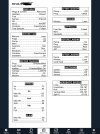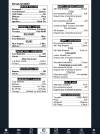We are all familiar with checklists but to the newer pilots are you familiar with the concept of flow? I once had an instructor Is who introduced me to the concept of flow across the airplane controls. He pointed out that the checklist was fine if you had time to do it, but if you need to get the airplane in operation and moving in a hurry your best bet was to generate a flow across the cockpit controls in an orderly fashion. After looking at this in more detail I found that the checklist we were using did not follow the flow very well at all. What if you had a checklist that matched everything in your flow so that you would have all your checklist items in the same order that you generally would accomplish them? That means your checklist and your flow of the controls would both match and you would do the same thing in the same order every time you fly your airplane. Over time you would become more efficient in operating your plane and in memorizing the checklist at the same time.
I wrote my first checklist when I was a new pilot and new aircraft owner with a new to me 1968 Piper Cherokee. I set out to make a checklist that was in the same order of my flow so that my flow and my checklist matched. As you can imagine this takes some time and forethought, but I think the results were well worth all of the efforts involved. As you become more experienced, and you become a better pilot sooner or later you're going to find that there are certain things that you do in a specific way. Sometimes you find something that is better if done differently than you used to do, and when you find these things, you need to incorporate them into your checklist. This means that as you grow as a pilot you may have to rewrite your checklist from time to time. I have just rewritten my checklist for my M20E and that's why I decided to write this post.
Have you ever heard of the GIFFTS Check? It stands for Gear Instruments Fuel Faps Trim and Situational awareness. I was taught this check the first time I was flying in a retractable gear aircraft. My problem was that situational awareness was the last thing on the list. To me it was more important to be situationally aware before you start each phase of the checklist. After I bought my Mooney, I racked my brain to figure out a good acronym that started with your situation and created a new checklist based on every situation you encountered. The acronym I use is SPAGFIT. It kind of reminds me of an old Jetsons episode where George Jetson trotted out a bad Cogswell cog as the problem of the machine Is he was working on. (I mean, in the space age are you actually going to use cogs and sprockets? Really? The satire is just too funny.)
SPAGFIT stands for Situation Power Airspeed Gear Fuel Instruments and Trim. The S always stands for Situation, but the others can have different meanings depending on what you're looking for at the time. The A can be Airspeed, Altitude ATIS or AOA and the F can be Flaps or Fuel. My checklist is now 14 separate lists divided into 13 different situations. Not all of flows follow the SPAGFIT format but most of them do.
My Mooney is an all mechanical airframe with a crank up entry step that I sometimes forget, so I tied it to the insertion of the ignition key. This action is really the beginning of engine start sequence as I usually don't have passengers with me. The M20E also has a ram air boost that bypasses the air filter during climb. This should be off or closed at all times on or near the ground, and only opened during climb in clean air. Another feature is a mechanically operated speed brake, along with hydraulically operated mechanical flaps, and cowl flaps for engine cooling. Some of these features are not OEM equipment and are not on any factory checklists. I took the classes for advanced LOP engine management and run LOP most of the time. That means I lean aggressively on the ground and in the air during cruise and descent. I have constant air flow and fuel flow curves on a graph to help me lean properly. I also use a TAS correction table to quickly determine true airspeed in cruise. These are both on one half-page front and back, and the checklists are also on one half-page front and back. I use these regularly from the beginning of the flight to the end.
I have individual checklists for each of these situations: Engine Startup, Pre-Taxi, Runup, Pre-Takeoff, Climb, Level-off at Altitude, Descend from Altitude, Pattern Level-Off, Pattern Final, After Landing, and Shutdown. The last item on the last situation is to remove the key and crank down the entry step. This is my third iteration of this checklist. It is not perfect, but it gets better with every rewrite. I think it does a good job of matching my flows to all the items needing attention in the cockpit. I wrote this in MS Word. I had some trouble with the formatting, but it works. If anyone reading this would like a copy of my source file send me a message and I'll send it to you. You can use it as a template for your own checklist if you choose to write one. I hope your checklist works as well for you as this one does for me.
I wrote my first checklist when I was a new pilot and new aircraft owner with a new to me 1968 Piper Cherokee. I set out to make a checklist that was in the same order of my flow so that my flow and my checklist matched. As you can imagine this takes some time and forethought, but I think the results were well worth all of the efforts involved. As you become more experienced, and you become a better pilot sooner or later you're going to find that there are certain things that you do in a specific way. Sometimes you find something that is better if done differently than you used to do, and when you find these things, you need to incorporate them into your checklist. This means that as you grow as a pilot you may have to rewrite your checklist from time to time. I have just rewritten my checklist for my M20E and that's why I decided to write this post.
Have you ever heard of the GIFFTS Check? It stands for Gear Instruments Fuel Faps Trim and Situational awareness. I was taught this check the first time I was flying in a retractable gear aircraft. My problem was that situational awareness was the last thing on the list. To me it was more important to be situationally aware before you start each phase of the checklist. After I bought my Mooney, I racked my brain to figure out a good acronym that started with your situation and created a new checklist based on every situation you encountered. The acronym I use is SPAGFIT. It kind of reminds me of an old Jetsons episode where George Jetson trotted out a bad Cogswell cog as the problem of the machine Is he was working on. (I mean, in the space age are you actually going to use cogs and sprockets? Really? The satire is just too funny.)
SPAGFIT stands for Situation Power Airspeed Gear Fuel Instruments and Trim. The S always stands for Situation, but the others can have different meanings depending on what you're looking for at the time. The A can be Airspeed, Altitude ATIS or AOA and the F can be Flaps or Fuel. My checklist is now 14 separate lists divided into 13 different situations. Not all of flows follow the SPAGFIT format but most of them do.
My Mooney is an all mechanical airframe with a crank up entry step that I sometimes forget, so I tied it to the insertion of the ignition key. This action is really the beginning of engine start sequence as I usually don't have passengers with me. The M20E also has a ram air boost that bypasses the air filter during climb. This should be off or closed at all times on or near the ground, and only opened during climb in clean air. Another feature is a mechanically operated speed brake, along with hydraulically operated mechanical flaps, and cowl flaps for engine cooling. Some of these features are not OEM equipment and are not on any factory checklists. I took the classes for advanced LOP engine management and run LOP most of the time. That means I lean aggressively on the ground and in the air during cruise and descent. I have constant air flow and fuel flow curves on a graph to help me lean properly. I also use a TAS correction table to quickly determine true airspeed in cruise. These are both on one half-page front and back, and the checklists are also on one half-page front and back. I use these regularly from the beginning of the flight to the end.
I have individual checklists for each of these situations: Engine Startup, Pre-Taxi, Runup, Pre-Takeoff, Climb, Level-off at Altitude, Descend from Altitude, Pattern Level-Off, Pattern Final, After Landing, and Shutdown. The last item on the last situation is to remove the key and crank down the entry step. This is my third iteration of this checklist. It is not perfect, but it gets better with every rewrite. I think it does a good job of matching my flows to all the items needing attention in the cockpit. I wrote this in MS Word. I had some trouble with the formatting, but it works. If anyone reading this would like a copy of my source file send me a message and I'll send it to you. You can use it as a template for your own checklist if you choose to write one. I hope your checklist works as well for you as this one does for me.
Attachments
Last edited:




